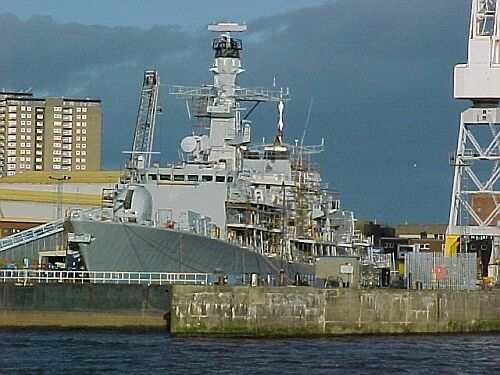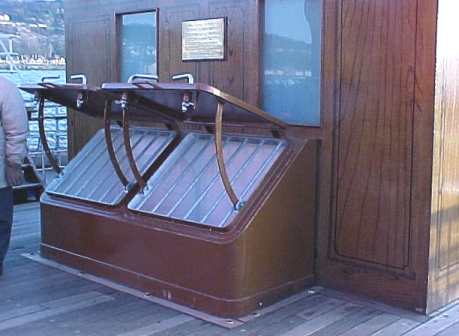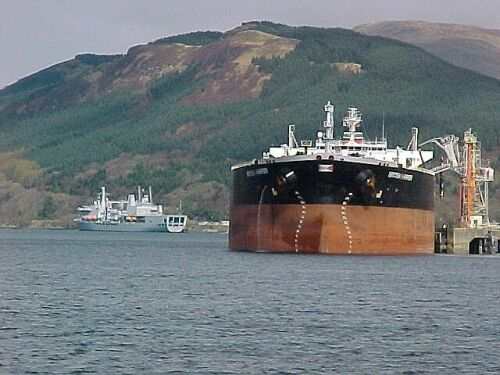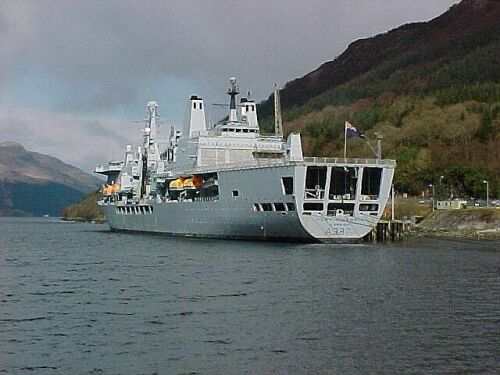<!--#easybanner-->
Easter Day - Big Ships
and 3 Spectacular Lochs
Words and pictures by Stuart
Cameron
| On Easter Day, Waverley left her
base as the sun broke through the cloud and the sun
became progressively more prevalent as she headed
downriver past the familiar sights, such as HMS St
Albans, fitting out at Yarrow's Shipyard. Sunny though it
was, it was not warm , the stiff northerly breeze having
a distinct bite. The actor and comedian Roy Baraclough
joined the steamer at Glasgow for a full day sailing and
seemed to enjoy his experience. |
 |
Waverley called at Greenock and Helensburgh then
crossed the mouth of the Gareloch to make her second visit of the
year to Kilcreggan after which she headed into Loch Long.
 |
The air was crystal clear but the
northerly course in the loch accentuated the windchill
and passengers were appreciative of the constant waft of
warm air emanating from the new hatch in front of the
purser's office. It is likely to become an even more
popular area to congregate and talk on cold days. |
Waverley turned to port when she reached the mouth of
Loch Goil and headed a short distance into the Loch affording her
complement a good view of the beautiful scenery. Turning off
Carrick Castle, Waverley retraced her wake to the entrance of the
loch where she turned to port to continue a short distance up
Loch Long. There was considerable interest on deck for this
section of the cruise as two large ocean ships were berthed at
terminals on the east shore of the loch.
| The first vessel that Waverley
passed was a large BP tanker called British Harrier,
which was berthed at the oil terminal at Finnart. This
terminal was built in the 1950s to facilitate the import
of crude oil from the Persian Gulf. Loch Long is a
sheltered, fjord like waterway of great depth. The
sharply shelving sides of the loch make it possible for
the largest supertankers in the world to berth at the
short pier. In the late 1970s, vessels in excess of
350,000 tonnes berthed at Finnart - by comparison British
Harrier was quite small. |
 |
When built, the terminal was intended as an import
terminal for the vast BP oil refinery at Grangemouth on the Forth
- a pipeline runs west to east across the central belt of
Scotland to join Finnart to Grangemouth. The discovery of oil in
the North Sea resulted in the Grangemouth refinery taking most of
its feed from that source over the past 20 years and during that
period Finnart has been partly 'mothballed'. More recently BP has
modified the pipeline to enable the export of Grangemouth
products through Finnart. British Harrier is the first BP owned
ship to visit Finnart in 30 years. In attendance with British
Harrier was the fire fighting Clyde tug Flying Phantom in her new
light blue livery. The tug is the last survivor of the fleet of
the Clyde Shipping Company, which can trace its origins back to
1814. The Company's tugs were famous for their 'Flying'
nomenclature style and the distinctive black, brown and orange
livery.
 |
After passing British Harrier,
Waverley continued further up the deep, narrow loch to
allow passengers a good close view of the huge RFA Fort
Victoria, berthed at the RNAD terminal just north of
Finnart. This quay is used to transfer ballistic missiles
from the vast, cavernous silos that are cut into the
mountains between Loch Long and Loch Lomond. In those
hills resides a huge arsenal of nuclear weaponry. Vessels
of the RFA have visited this quay for many years to
transfer Polaris, Poseidon and now Trident missiles from
the caverns to the ICBM submarine fleet based at Faslane
in the Gareloch. Fort Victoria is one of the largest RFA
vessels ever built and the ability to berth her so close
to the loch side is proof of the steep sides and depth of
this loch. |
Turning abeam of Fort Victoria, Waverley headed back
down the loch past the massive floating dock and high security
armaments base at Coulport , round the Roseneath Peninsula
and through the Rhu Narrows for a rare visit to the Gareloch.
This loch was the virtual preserve of the North British Railway's
Craigendoran based fleet of paddle steamers, of which Waverley is
the last survivor. Waverley's return to the haunts of the
venerable Lucy Ashton was the first return of the old LNER livery
to the loch in fifty three years. She proceeded along the loch
until she was adjacent to the site of the former Metal Industries
shipbreaking yard at Faslane. Many famous ships - liners,
battleships and aircraft carriers had ended their days in that
bay just a mile or so south of Garelochead.
Probably the most famous ship to be demolished at
Faslane was the very beautiful Cunard liner Aquitania that was
scrapped there in the early fifties - only twenty miles away from
the place of her creation, the John Brown shipyard in Clydebank.
The shipbreaking yard at Faslane was itself demolished in the
1970s to make way for the vast naval base that is home to the
majority of the British submarine fleet. Tucked in on the edge of
the enormous high security base is the little boatyard of
Timbacraft of Shandon, which has for many years serviced the
smaller members of CalMac's Clyde and West Highland fleets. From
Waverley's deck we could see Clyde Marine Motoring's little
passenger ferry Kenilworth, hauled up from the water for overhaul
and one of Calmac's fleet of small bow loading car ferries. It
was on the shores of the Gareloch in this vicinity that once
stood the vast Shandon House, home of Robert Napier, widely
regarded as the 'Father of Clyde Shipbuilding' Robert Napier
designed the four paddle steamers that formed the nucleus of
Samuel Cunard's emerging fleet of transatlantic mail steamers in
the 1840s and introduced Cunard to the Glasgow shipping magnate
Sir George Burns who, with partner Donald MacIver, put up most of
the money to get the famous Cunard line started. Napier trained
many men in his yard that were to go on to found their own
companies on the banks of the river - names like Denny, Thomson,
Elder and many more learned their trade under the influence of
Robert Napier.
As we steamed back down the Gareloch one could only
imagine those years in the 1930s when scores of idle British
ships were laid up in rows in its sheltered waters and reflect
how much the scenic lochside has changed from a beautiful
backwater disturbed only occasionally by the flapping of a North
British paddle boat through the depressed ranks of silent ships
of the hungry thirties, the busy emergency port of World War 2,
the early days of the submarine base with its well known
mother-ship, HMS Maidstone, and the overpowering and somewhat
sinister presence of the current Trident base. Maybe some day the
Gareloch will return to its natural state. Let's hope that
Waverley is still flapping around at that time.
Return to Easter 2001 Index



